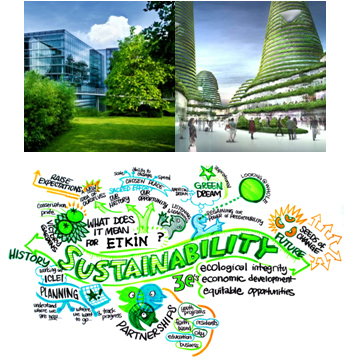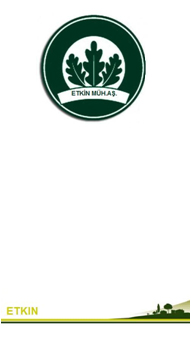|
SUSTAINABLE DEVELOPMENT
 |
In our designs, work and approaches, our mission is meeting the need ofthe presentwithoutcomprimising the ability of future generations tomeettheirownneeds. Consequentlygreen building designing and implementationsare our noteworthyindications of our sustainable company
development.
Why we chooseexperiencinggreen ?
By reason of;
• Economical and efficient apprehension
• Enviromentalistmovement
• CorporateSocialResponsibility
We are involving with Green Building Technologies :
• We have developed an expertstaffmastering on LEED, BREEAM, DGNBcertificationperiods.
• Project Management: We are designing and constructing projects thatmeet ASHRAE etc. standarts, resolvingmuch of the negativeimpact ofbuildings on theiroccupants and on the environment.
• Accreditation Processes: We are managing the accreditataionprocesses of green building certifications
• Energy Simulation: To establish the minimum level of energyefficiency for the proposed buildings and systems; we are doing thewhole building’s energy simulation.
• EnhancedCommissioning: We begin the commissioning processearly in the design process and execute additional activities after systemperformanceverification is completed.
|
 |
SUGGESTIONS FOR A SUSTAINABLE LIFE
ENERGY AND GREENHOUSE GAS EMMISSIONS
- All enclosed spaces are required to use energy saving lightbulbs, while offices make use of dimmer switches.
- The use of A category Energy products must be ensured as standard.
- Bio-diesel generators are used, and sound insulation is used out of environmental considerations.
- Windows must use UV resistant glass and facades exposed to sunlight must feature light diverters.
- In order to achieve optimum energy consumption in heating, cooling and lighting, buildings must be located such that they make best use of daylight and fresh air.
- The use of green electrical energy must be ensured whether in commercial or private premises in line with parallel legal changes.
- Hot water is produced by solar energy, and for heating, solar energy and gas-powered energy as well as lighting, are used.
- Swimming pools must make use of solar heating.
- Lighting in communal spaces, and CCTV (Closed Circuit TV systems) that work on electrical energy must be adapted to use photovoltaic batteries.
- For central heating systems the combination of a regular power supply with alternative systems (CHP System-Combined Heat and Power Systems) for hot, water, heating and electrical energy is preferred.
- Wherever the ground structure is suitable, geothermal heating and cooling usage is made use of.
- Thermal energy should be opted for in new settlements located in those regions of Turkey that have natural thermal energy resources.
- Insulation must be used to conserve energy, and therefore reduce the greenhouse effect.
WATER USAGE
- In water usage pneumatic taps, economy-flush toilets and economic showers are used.
- The collecting of rainwater enables recycling for garden watering or domestic water usage.
- Water emerging from showers and washing machines, either with or without the addition of rainwater, is used in toilets.
- Special reservoirs for wastewater are provided to boost the organic filtration and watering of gardens.
- Once purified, waste water can be combined with rainwater and drainage water in reservoirs or artificial lakes for use in the watering of gardens. (In larger projects in particular, the local topography itself may be exploited).
MATERIALS
- Construction and building materials make use of natural wood. Accordingly, only materials bearing the stamp of the Foresty Stewardship Council, an international organization, are used. These materials are made from felled trees that are replaced with newly planted ones in the same amount. Turkey complies with the PEFC (Programme for the Endorsement of Forest Certification). Agreements with contractors also encourage the planting of trees.
- Wherever possible local products are used.
- The use of recycled materials is preferred.
- Wherever possible natural materials are used.
- Building work aims at minimising the waste of construction materials.
SURFACE WATER
- Wherever possible, when creating gardens the laying of hard surfaces should be avoided.
- Sustainable drainage systems are provided. Water quality is raised by use of green rooves to collect rainwater. Water collected in drainage systems is then recycled.
WASTES
- The sorting of waste products and recycling of rubbish must be given to specialized companies.
- Villas must be provided with galvanized boxes for waste compost.
- Waste management systems must be in place during construction.
- Incentives must be in place for waste management systems to be established for operation after construction, and once properties are inhabited.
POLLUTION
- Products made from MDF should not be used inside buildings, as they negatively impact air quality.
- Oil traps should be provided in areas where cars are parked (garages).
HEALTH AND WELFARE
- The garages of all appartments should be accessible to the disabled.
- Sound insulation must be ensured.
- Silent and restful outdoor areas must be created.
- Appartment bathrooms and toilets must be accessible to the disabled and elderly.
- Appartment bathrooms should feature baths designed for convenient use by the disabled
- All walkways must be coated appropriately for the visually impaired (estate exits, steps building entrances, etc.).
ADMINISTRATION
- In the interests of sustainability, a users guide should be prepared both for those involved during the construction phase, and indicating what should be done when in use.
- It is necessary to employ relevant staff to inform residents on the collection and sorting of rubbish.
- Notices ecouraging resident awareness of water, electricity and energy conservation, and informing them of savings amounts and measurements should be provided in easy to see places.
ECOLOGY
- The use of local plants and, with an eye to global warming, varieites that require little watering,
- Explaining to homeowners and their children the nature of plants and the effects of biological change on them.
- Providing space for climbing plants on building facades.
- The implementation of green roofing;
- Sustainable drainage systems must be provided.
TRANSPORT
-
- In order to provide a good, sustainable transport system, public transport timetables must be placed in easily seen places.
- When designing residential areas, close attention should be paid to their proximity to shopping centers and offices.
|